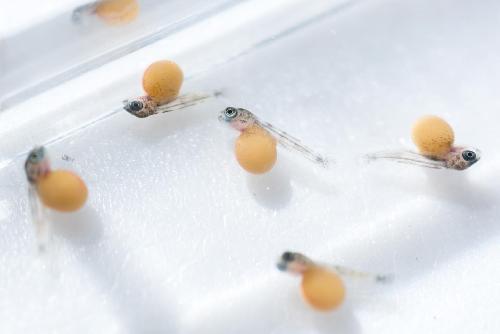When a Lake Malawi cichlid loses a tooth, a new one drops neatly into place as a replacement. Why can't humans similarly regrow teeth lost to injury or disease?
Working with hundreds of these colorful fish, researchers are beginning to understanding how the animals maintain their hundreds of teeth throughout their adult lives. By studying how structures in embryonic fish differentiate into either teeth or taste buds, the researchers hope to one day be able to turn on the tooth regeneration mechanism in humans - which, like other mammals, get only two sets of teeth to last a lifetime.
The work, which also involved a study of dental differentiation in mice, shows that the structures responsible for growing new teeth may remain active for longer than previously thought, suggesting that the process might be activated in human adults.

The research was conducted by scientists from the Georgia Institute of Technology in Atlanta and King's College in London, and published October 19 in early edition of the journal Proceedings of the National Academy of Sciences. The research was supported by the National Institute of Dental and Craniofacial Research, part of the U.S. National Institutes of Health.
"We have uncovered developmental plasticity between teeth and taste buds, and we are trying to understand the pathways that mediate the fate of cells toward either dental or sensory development," said Todd Streelman, a professor in the Georgia Tech School of Biology. "The potential applications to humans makes this interesting to everybody who has dealt with dental issues at one time or another in their lives."
Worldwide, nearly 60 percent of persons have lost all their teeth by the time they reach the age of 60. Beyond the painful dental health issues, this can causes significant medical and nutritional problems that can shorten life.
To understand more about the pathways that lead to the growth and development of teeth, Streelman and first author Ryan Bloomquist - a DMD/PhD student at Georgia Tech and Georgia Regents University - studied how teeth and taste buds grow from the same epithelial tissues in embryonic fish. Unlike humans, fish have no tongues, so their taste buds are mixed in with their teeth, sometimes in adjacent rows.
The Lake Malawi cichlids have adapted their teeth and taste buds to thrive in the unique conditions where they live. One species eats plankton and needs few teeth because it locates its food visually and swallows it whole. Another species lives on algae which must be scraped or snipped from rocky lake formations, requiring both many more teeth and more taste buds to distinguish food.
The researchers crossed the two closely-related species, and in the second generation of these hybrids, saw substantial variation in the numbers of teeth and taste buds. By studying the genetic differences in some 300 of these second-generation hybrids, they were able to tease out the genetic components of the variation.
"We were able to map the regions of the genome that control a positive correlation between the densities of each of these structures," Streelman explained. "And through a collaboration with colleagues at King's College in London, we were able to demonstrate that a few poorly studied genes were also involved in the development of teeth and taste buds in mice."
By bathing embryonic fish in chemicals that influence the developmental pathways involved in tooth and taste bud formation, the researchers then manipulated the development of the two structures. In one case, they boosted the growth of taste buds at the expense of teeth. These changes were initiated just five or six days after the fish eggs were fertilized, at a stage when the fish had eyes and a brain - but were still developing jaws.
"There appear to be developmental switches that will shift the fate of the common epithelial cells to either dental or sensory structures," Streelman said.
Though they have very different purposes and final anatomy, teeth and taste buds originate in the same kind of epithelial tissue in the developing jaws of embryonic fish. These tiny buds differentiate later, forming teeth with hard enamel - or soft taste buds.
"It's not until later in the development of a tooth that it forms enamel and dentine," said Streelman. "At the earliest stages of development, these structures are really very similar."
The studies in fish and mice suggest the possibility that with the right signals, epithelial tissue in humans might also be able to regenerate new teeth.
"It was not previously thought that development would be so plastic for structures that are so different in adult fish," Streelman said. "Ultimately, this suggests that the epithelium in a human's mouth might be more plastic than we had previously thought. The direction our research is taking, at least in terms of human health implications, is to figure out how to coax the epithelium to form one type of structure or the other."
But growing new teeth wouldn't be enough, Streelman cautions. Researchers would also need to understand how nerves and blood vessels grow into teeth to make them viable.





Comments